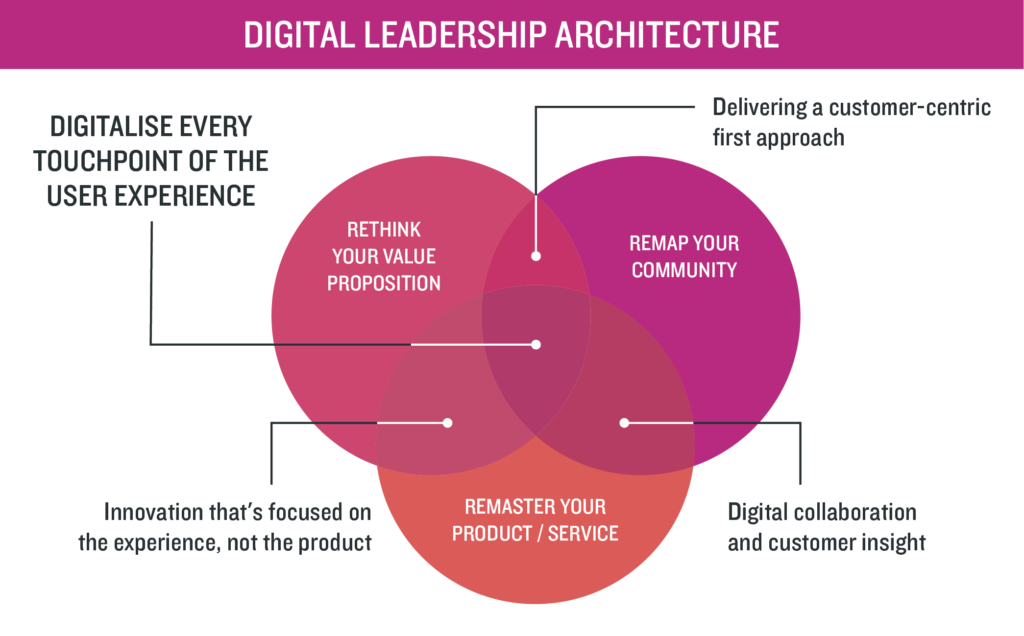
Did you know Warren Knight, the author of this piece, is speaking at TNW2020 this year? Check out their session on ‘What’s next for the digital-first mindset?’ here.
Before we go any further, I’ve said this before, but it’s the single most important thing I want you to understand, so I’m going to keep saying it.
Total successful digital transformation isn’t just about the technology. It’s about people. So by digitally transforming your business, you’re aiming to digitize every single touchpoint of the user experience.
In other words, it doesn’t matter how sophisticated the tech is. If the user experience isn’t right, the (probably considerable) investment you’ve made isn’t going to succeed. If your organization is, and remains, focussed on operating a process rather than delivering an outcome, you’ll struggle. The great thing about digital is that encourages you to focus on outcomes.
Companies that get digital transformation right, approach it in a structured way that supports innovation and values technology whilst never losing sight of their ultimate strategic goal.
The simplest way to approach this is by beginning with the three essential pillars of digital leadership architecture, expressed as a Venn diagram.

These three essential areas leaders need to cover in digital transformation are all based on understanding your most important goal: to create value larger than the amount of investment you are making.
Rethink
Your first step is to rethink your value proposition. How will digital transformation make what your brand offers more about the customer?
Remap
Do you have a clear picture of your community? Not just who they are but what they most want? How will digital transformation allow you to anticipate and meet their needs now – in one year, in five? Understanding this takes customer insights. Your digital transformation journey must factor in developing the capacity to be constantly updating and adding to the data you’re collecting about your community; allowing you to track, analyze, and understand what they want.
Remaster
Understanding your community reveals what they want, and allows you to turn the way you look at your offer on its head. Instead of asking how you can develop your product, you need to be looking at innovation focussed on the question of how you can deliver an exceptional customer experience.
Bring all of these elements together and you have the basis for digitalizing every touchpoint of the user experience.
Let’s look at an example:
Babolat: blurring the lines between physical and digital
In 2013, when established French tennis racquet brand Babolat wanted to reinvigorate their brand, they looked to technology to do it. But in a way that added real value to their proposition in the eyes of their customers. In fact, they had been planning the move for over a decade, but it took a while for the technology to catch up with the idea (lesson:digital transformation can be a long game, and just because you can’t do something right now doesn’t mean you should can the idea!).
Monitoring devices for runners were becoming pretty common, but options for tennis were non-existent. By packing technology (including an accelerometer, gyroscope and microprocessor board) into the normally hollow handle, Babolat enabled players to connect their Play Pure Drive racquet to the Babolat Play app on their smartphone or tablet, allowing them to review their performance data, upload and share stats and share information across the Babolat community. Performance monitoring apps are pretty common these days, but back in 2013 this was a revolutionary development in tennis, making the Pure Drive the first racquet to cross over from product to service.
Previously racquet technology was all focussed on the product – strength, weight, power, control. But there was no direct way for a player to assess how their personal technique interacted with all that clever, innovative kit. What Babolat’s innovation did was connect the player and the racquet, enabling the racquet itself to become part-tennis coach. And it was no gimmick. Even without the tech, the kit is described as a serious racquet, whether connected or not.
But beware. It’s not all good news. The second part of the Babolat lesson is that you have to stay on top of your game, too. Look up the app in AppStore today and you’ll find a series of negative reviews about recent upgrades to the app, reporting bugs, crashes, synching issues and lack of customer service. The racquet may be world-leading, but if the interface lets down the customer experience, the brand’s reputation suffers.
It’s not enough just to innovate. Let’s remind ourselves of the crossover areas in the Venn diagram we looked at:
- Delivering a customer centric approach;
- Digital collaboration and customer insight; and
- Innovation focussed on the experience, not the product
Without achieving these, you won’t achieve the Holy Grail in the middle: successful digitalization of EVERY touchpoint of the user experience.
Which brings us nicely to the second half of this article.
The essential competencies of a successful digital leader
As a leader of digital transformation you will need to develop or acquire a number of core strengths. And if you are conscious that any of these lie outside your key skills portfolio, you’ll need to ensure that you build a team that complements your own strengths and fills any gaps.
Creating value
Remember, earlier we identified that your most important goal was to create value above the level (ideally WAY above) of the investment you are making (and asking others to make) in digital transformation. You’ve got to be able to deliver on the bottom line.
Creating value means being customer-focused, but also demands an ability to balance innovation with risk-taking in order to deliver results.
As a leader, you need to understand the customer, their problems and how to solve them. To gain greater insight, you have to be prepared to challenge assumptions and propose not just new solutions, but new ways of looking at the problem. And you need to be able to encourage and motivate your teams to do the same.
Executing strategy
As a successful leader, you’ll be a long-term thinker, able to craft, communicate and execute a strategy focused on ambitious goals. You’ll need to be a team builder able to communicate the vision and strategy and manage your own accountability as well as ensuring your team becomes responsible and accountable for their own roles in the transformation process.
You’ll need to be able to clearly define and articulate mission, vision, values goals and strategy and set the direction of travel, with specific targets and key milestones.
You’ll be a knowledge sharer, able to work across boundaries and provide critical feedback at all levels.
Your vision will be what enables you to craft strategies which add the essential value, as well as motivating, mobilising and guiding your team through the process of transformation.
Leadership talents
As leader in a transformation process there are certain key attributes that will be indispensable to you. These can be learned and developed, but it’s important to recognize that the so-called ‘soft’ skills are a vital aspect of transformation management, as these are critical to creating and driving a highly motivated, engaged and enabled team.
Learning by doing, leading by example and developing a strong coaching style will all enhance your digital leadership abilities. You’ll invest time in developing your own strengths and talents, but also ensure that your business culture supports investment in people’s skills across the board.
In leading by example, the high standards you set for everyone on your team will be matched or exceeded only by the standards you set for yourself; and in learning by doing you will demonstrate to your teams the value that you place on developing new competencies.
You will need a genuine desire to get the best out of everyone on the team, whilst being prepared to critically evaluate performance and hold individuals to account as and when necessary.
You’ll need to be able to be completely honest with yourself and your management team when it comes to identifying skills gaps and assessing whether training and development within the team can fills those gaps, or whether you need to recruit new talent. Whichever it is, you’ll need to have the critical skills to assess progress.
It used to be the case that ‘digital’ was a specific team within an organization. But as Elizabeth Fagan, Marketing Director Health and Beauty, International Brands, Alliance Boots points out in Deloitte’s report ‘Building your digital DNA’, “There used to be a digital team but increasingly now it’s marbled through the organization. We have tried to embed digital talent across teams.”
As a successful leader in digital transformation, it will be essential that you are able to recognize the need to see digital as a core part of your brand’s DNA, build a team that supports this vision, and put the customer experience at the centre of the business.
This article was originally published on Warren Knight’s blog. You can read it here.
Get the TNW newsletter
Get the most important tech news in your inbox each week.





